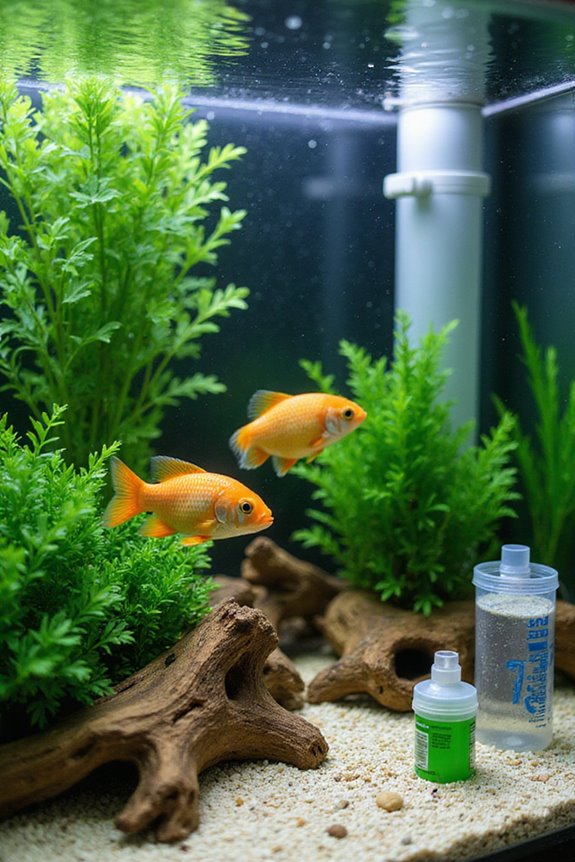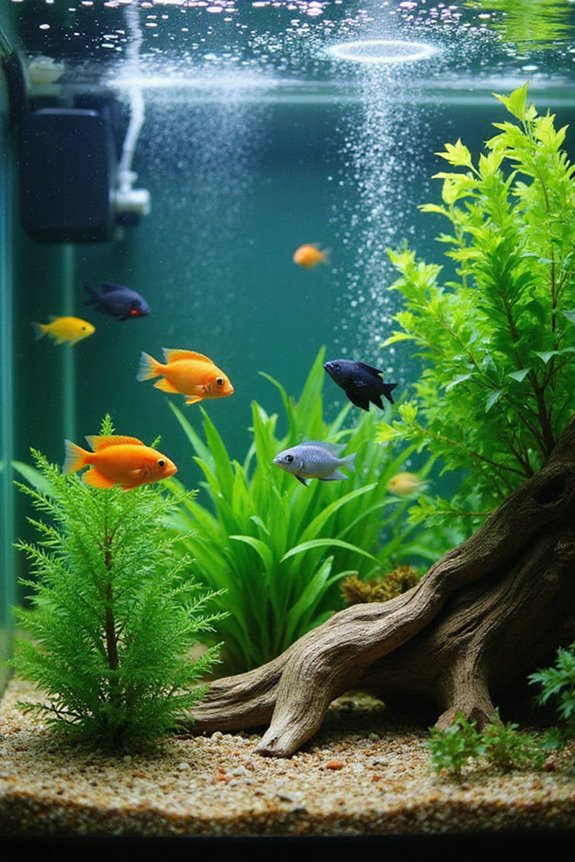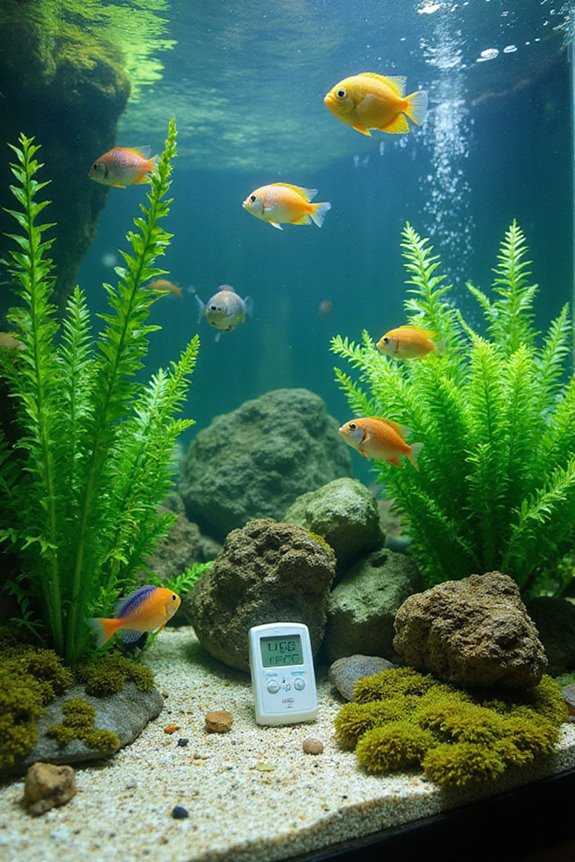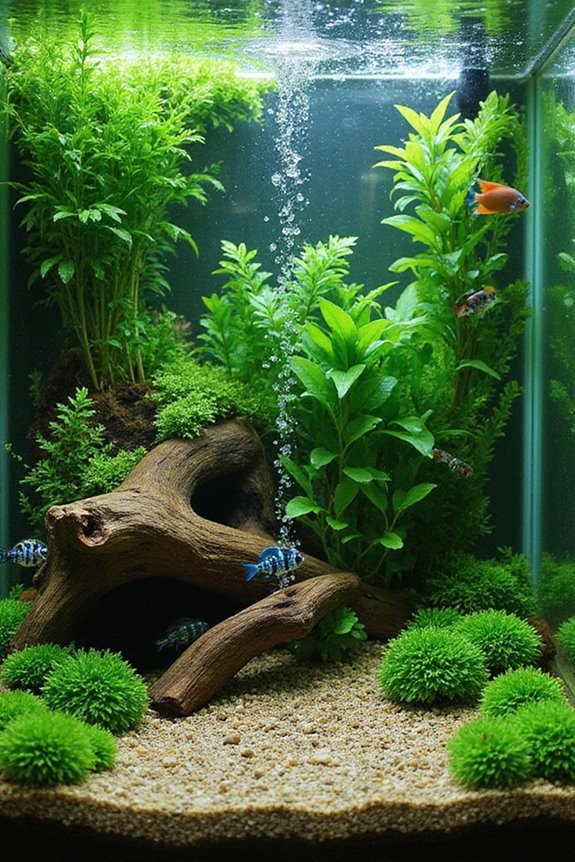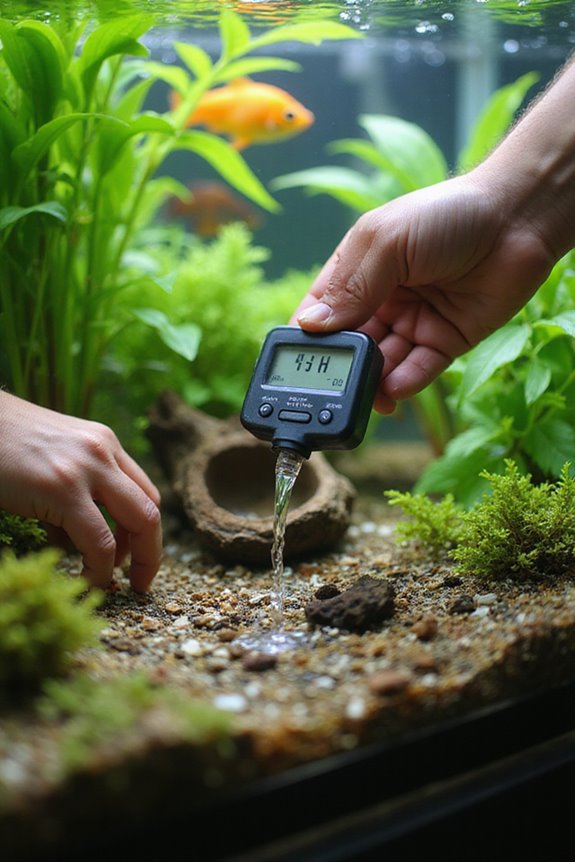To lower nitrites in your fish tank, I recommend first adding beneficial bacteria using products like TurboStart to boost nitrifying populations. Next, perform partial water changes of 25-50% weekly to dilute nitrite levels. Use established filter media like ceramic rings to enhance biological filtration. Adjust your feeding practices by providing small amounts of high-quality food that fish can consume in a few minutes, preventing waste buildup. These steps will help you maintain a healthier tank environment. Look for more tips on effective management.
Key Takeaways
- Perform a water change of 25-50% to dilute nitrite concentrations quickly and improve water quality.
- Use bacterial supplements like TurboStart to boost beneficial bacteria that convert nitrites to nitrates.
- Introduce live plants to absorb excess nitrites and enhance natural filtration in the tank.
- Monitor and adjust feeding practices to prevent uneaten food from decaying and contributing to nitrite buildup.
- Utilize nitrite-removing products as a temporary solution to quickly address high nitrite levels.
Adding Beneficial Bacteria
Adding beneficial bacteria to your fish tank is essential for maintaining a healthy environment, especially when you’re trying to lower nitrite levels. I often use bacterial supplements, like TurboStart, to boost the population of nitrifying bacteria. These bacteria, such as Nitrosomonas and Nitrobacter, play an important role in breaking down toxic ammonia into nitrite and then converting that nitrite into less harmful nitrate. To introduce these bacteria, I add the supplement directly to the filter media or gravel, ensuring ideal water parameters and oxygen levels for their growth. It’s important to avoid harsh chemicals that could harm these crucial organisms. With patience, these beneficial bacteria will establish themselves, helping to maintain a balanced tank and keep nitrite levels in check. Using biodegradable fishing lines can also contribute to maintaining cleaner waterways and healthier aquatic environments for both wild and captive fish species.
Performing Partial Water Changes
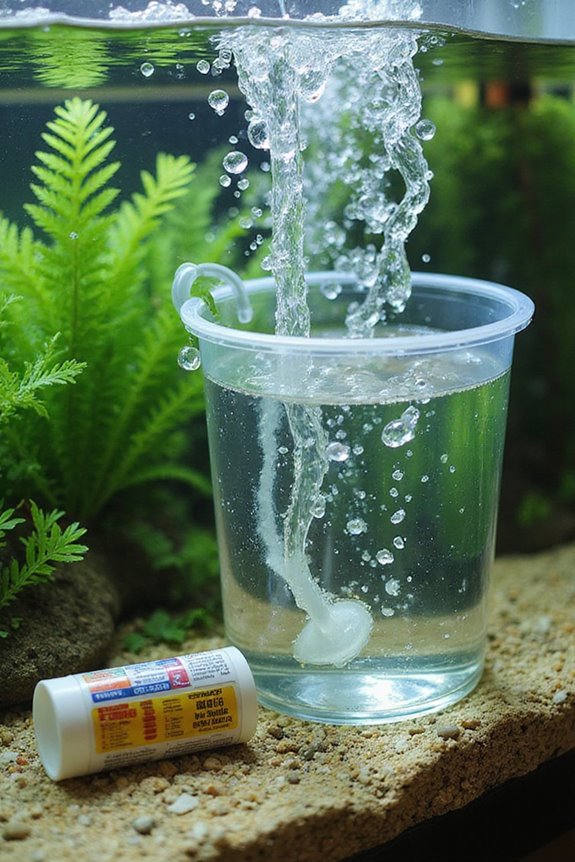
Performing partial water changes is one of the most effective ways to manage nitrite levels in your fish tank. I typically recommend changing 25-50% of the water weekly or biweekly to maintain low nitrite levels. Using siphon techniques, I remove water and detritus from different areas of the tank, focusing on debris hotspots. It’s essential to prepare replacement water by treating tap water with dechlorinators like Seachem Prime and ensuring its temperature matches the tank’s to prevent shock. After large changes, I keep a close eye on water parameters for any fluctuations. Regular changes not only dilute nitrites but also help reset pH and maintain a stable environment for my fish, promoting their overall well-being. If you’re planning extended absences, consider installing a moisture-proof feeder that won’t contaminate the water with excess food that could increase nitrite levels.
Using Filter Media From Established Aquariums
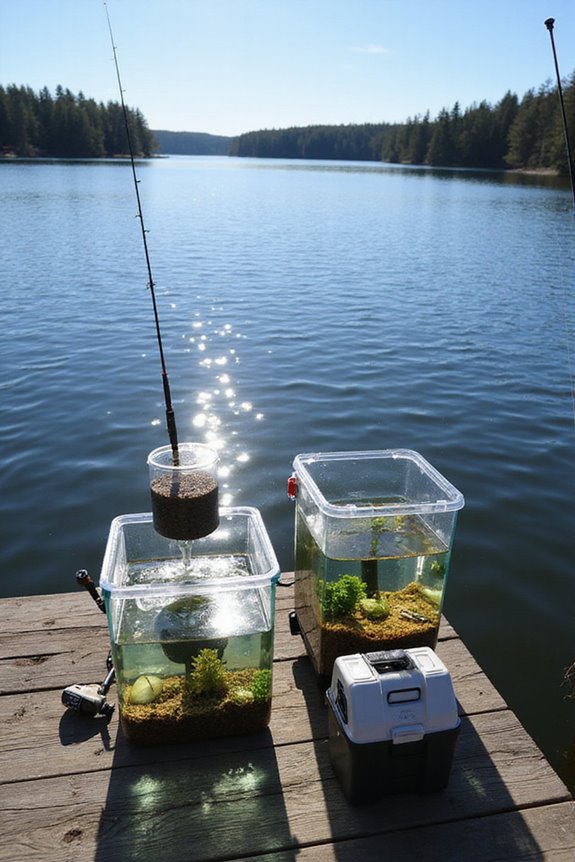
Using filter media from established aquariums is a highly effective method for rapidly lowering nitrite levels in your fish tank. I recommend sourcing established media, like ceramic rings or sponge filters, as they provide a surface area rich with beneficial bacterial colonies. Place this media directly in your filter’s water flow path to maximize contact. Mixing biological media, such as bio balls with chemical options like API NITRA-ZORB, can manage nitrite spikes more effectively. Regularly recharge resin-based media to maintain their effectiveness. Remember to avoid any media that absorbs ammonia or nitrite if you want to support bacterial growth. Adding aquarium cave decorations can create safe hiding spots for fish while also providing additional surface area for beneficial bacteria to colonize. By utilizing established media, you can quickly enhance your tank’s biological filtration, ensuring a healthier environment for your fish.
Adjusting Fish Feeding Practices
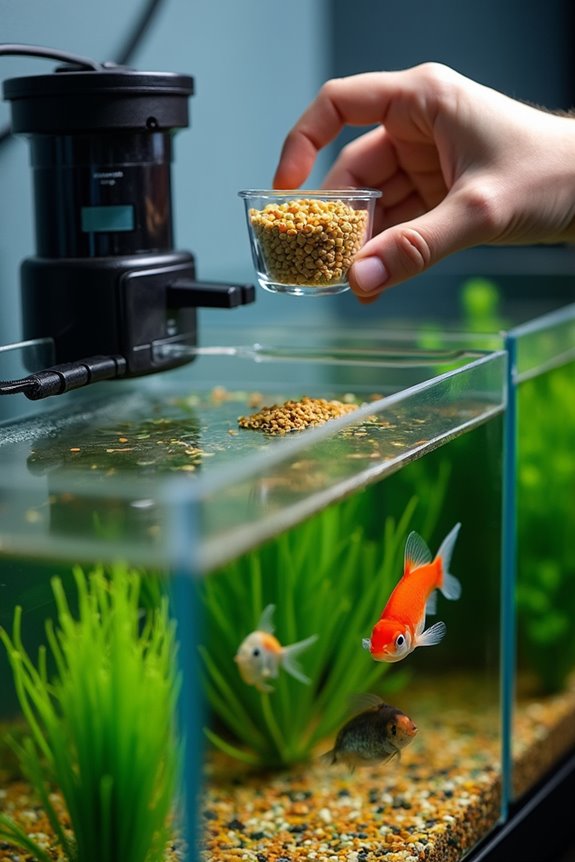
Adjusting fish feeding practices is essential for maintaining stable nitrite levels in your aquarium. First, I recommend establishing consistent feeding schedules, typically once or twice a day depending on your fish species. Feed only what your fish can consume within 2-3 minutes to prevent uneaten food from decomposing and raising nitrite levels. Choosing high-quality food is vital, as it decomposes more slowly and promotes better consumption. Use feeding rings to concentrate food and make it easier to monitor leftovers. Additionally, observe your fish’s appetite and adjust the quantity accordingly to reduce waste. By tailoring your feeding methods to each species and prioritizing food quality, you can effectively lower nitrite levels in your tank.
Adding Aquarium Salt With Caution
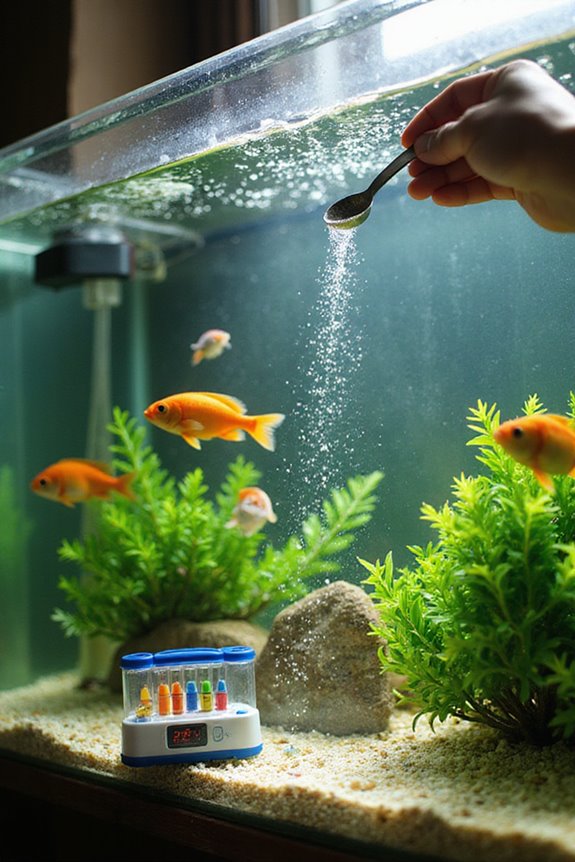
When you’re looking to lower nitrite levels in your aquarium, adding aquarium salt can be a helpful strategy, but it requires careful consideration. The typical salt dosage is about 1 teaspoon per 10 gallons of water, which effectively detoxifies nitrites. I recommend dissolving the salt in a small container before adding it to your tank to avoid concentrated spikes. It’s essential to monitor fish sensitivity, as not all species tolerate salt well. In tanks with plants, opt for lower doses to prevent damage. Keep an eye on your fish’s behavior after adding salt to guarantee they’re not stressed. Remember, salt should be a temporary solution during nitrite spikes, not a permanent fix.
Maintaining Regular Tank Maintenance
Maintaining regular tank maintenance is vital for keeping nitrite levels in check and guaranteeing a healthy environment for your fish. I recommend performing weekly water changes, replacing 10-30% of the tank water with dechlorinated water at the same temperature. During these changes, gravel siphoning is essential. It helps remove organic waste and uneaten food that contribute to nitrite buildup.
Filter cleaning should occur monthly, rinsing filter media in tank water to preserve beneficial bacteria. Inspect and clean your equipment regularly to guarantee peak filtration efficiency. Additionally, removing dead plant material and uneaten food will reduce nutrient sources for bacteria that produce nitrites. By following these steps, you’ll create a cleaner tank that promotes a stable environment for your aquatic life.
Monitoring Water Parameters
After establishing a routine for regular maintenance, the next step is monitoring water parameters, which plays a vital role in controlling nitrite levels. I regularly test the nitrite (NO2-) concentration using strip tests or digital monitors, as nitrite toxicity can harm fish even at low levels. It’s important to check pH, as a lower pH can reduce nitrite toxicity, but I make sure it doesn’t impact beneficial bacteria. I also evaluate ammonia and nitrate levels to understand the nitrogen cycle status. Using a carbonate hardness (KH) test helps stabilize pH, making nitrite management easier. I keep detailed logs of my test results, tracking changes after water changes or introducing new fish to identify patterns and act promptly if nitrite levels rise.
Managing Fish Stocking Levels
Managing fish stocking levels is essential for maintaining a healthy aquarium environment, especially regarding nitrite control. I recommend following the rule of thumb: no more than one inch of fish per gallon. This keeps waste production manageable. Gradual stocking is key. Introduce a few fish at a time, allowing beneficial bacteria to adjust and process the waste. Monitor water parameters weekly during this period to catch nitrite spikes early. Opt for fish compatible with each other to minimize stress, which can lead to increased waste. Start with hardy species to establish a stable biofilter before adding more sensitive ones. Always guarantee your filter system has a high surface area to support nitrifying bacteria, further aiding nitrite control.
Implementing a Quarantine Process
Implementing a quarantine process is essential for ensuring the health of your main aquarium, especially when introducing new fish. I recommend setting up a separate quarantine tank that’s cycled for a minimum of 4–6 weeks. This allows beneficial bacteria to thrive, reducing ammonia and nitrite levels. During this quarantine duration, monitor water parameters daily to detect any spikes. Introduce less sensitive fish only when the water is stable, as sudden changes can cause fish stress. Also, using established filter media from your main tank can help speed up the cycling process. Remember to perform regular water changes if nitrites exceed 1 ppm, ensuring the replacement water is treated and matches the tank’s temperature and pH.
Frequently Asked Questions
How Do I Know if My Nitrite Levels Are Safe?
Did you know that even 0.5 ppm nitrite can be dangerous? I always recommend regular nitrite testing; safe levels should be 0 ppm. Observing your fish’s behavior can also help indicate if something’s wrong.
Can Nitrites Affect Plant Health in the Aquarium?
Absolutely, I’ve seen nitrites negatively impact plant growth in my aquarium. Elevated levels disrupt root function, harming the overall aquatic ecosystem. It’s essential to manage nitrites for the health of both plants and fish.
What Are the Symptoms of Nitrite Poisoning in Fish?
Did you know that 60% of fish owners overlook nitrite levels? If you notice gasping at the surface or lethargy, these stress signs could indicate serious threats to your fish health. Act quickly!
How Quickly Can Nitrite Levels Rise in a Tank?
Nitrite levels can rise quickly during tank cycling, often within a few days. I’ve seen nitrite spikes occur as bacteria struggle to keep up with ammonia, making regular monitoring essential for maintaining fish health.
Are Certain Fish More Sensitive to Nitrites Than Others?
Like a delicate flower, some fish species show significant nitrite sensitivity. Coldwater species, for instance, are often more vulnerable than warmwater ones. Understanding these differences is essential for maintaining a healthy aquatic environment.

